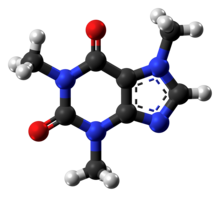ကေဖိန်း
ကေဖိန်း (အင်္ဂလိပ်: Caffeine) (Also ကဖိန်း) ဆိုသည်မှာ လက်ဖက်၊ ကော်ဖီစေ့နှင့် ကိုလာစေ့များတွင် ပါရှိသည့် အဲလ်ကာလွိုက် တစ်မျိုးဖြစ်၍ ရေတွင်ပျော်လွယ်သည်။ သွေးကြောများကျယ်၍ လန်းဆန်းစေသော အာနိသင် အနည်းငယ်ရှိသည်။ ဆေးဝါးများတွင် ရောစပ်သုံးစွဲကြသည်။ ကေဖိန်းသည် ကမ္ဘာအနှံ့ တွင်ကျယ်စွာ သုံးစွဲနေသည့် စွဲလမ်းစေတတ်သော မူးယစ်ဆေးဝါးဖြစ်သော်လည်း ယင်းသည် တရားဝင်ဖြစ်သည်။ ကေဖိန်းသည် အာရုံကြောစနစ်၏ သေချာသည့်အပိုင်းတစ်ခုကို လှုံ့ဆော်ပေးသည်။ ကေဖိန်းဓာတ်အား အပင်၏ အစေ့၊ အရွက် စသည်တို့တွင် တွေ့ရလေ့ရှိပြီး လူသိများသော ပင်ရင်းမှာ ကော်ဖီစေ့ဖြစ်သည်။ ကေဖိန်းဓာတ် ပါဝင်သော သောက်စရာ ကော်ဖီ၊ ကိုလာ၊ လက်ဖက်ရည်တို့သည် လူကြိုက်များပြီး ၂၀၀၅ ခုနှစ်အရ မြောက်အမေရိကမှ ၉၀ ရာခိုင်နှုန်းသော အရွယ်ရောက်ပြီးသူများသည် ကေဖိန်းဓာတ်ကို နေ့စဉ် သုံးစွဲကြသည်။[၁၁] ကေဖိန်းအားသုံးစွဲရာ၌ ကောင်းကျိုး၊ ဆိုးကျိုး ရှိလေသည်။ ကမ္ဘာ့ကျန်းမာရေးအဖွဲ့၏ ဆေးစာရင်းတစ်မျိုးဖြစ်သကဲ့သို့[၁၂] အချို့သော ရောဂါများကိုလည်း ထိရောက်စွာ ကာကွယ်ပေးသည်။[၁၃]
ကိုးကား
[ပြင်ဆင်ရန်]- ↑ Caffeine။ 16 November 2021 တွင် ပြန်စစ်ပြီး။
- ↑ ၂.၀ ၂.၁ Malenka RC၊ Nestler EJ၊ Hyman SE (2009)။ "Chapter 15: Reinforcement and Addictive Disorders"။ in Sydor A၊ Brown RY (eds.)။ Molecular Neuropharmacology: A Foundation for Clinical Neuroscience (2nd ed.)။ New York: McGraw-Hill Medical။ p. 375။ ISBN 978-0-07-148127-4။
Long-term caffeine use can lead to mild physical dependence. A withdrawal syndrome characterized by drowsiness, irritability, and headache typically lasts no longer than a day. True compulsive use of caffeine has not been documented.
- ↑ ၃.၀ ၃.၁ Karch SB (2009)။ Karch's pathology of drug abuse (4th ed.)။ Boca Raton: CRC Press။ pp. 229–230။ ISBN 978-0-8493-7881-2။
The suggestion has also been made that a caffeine dependence syndrome exists ... In one controlled study, dependence was diagnosed in 16 of 99 individuals who were evaluated. The median daily caffeine consumption of this group was only 357 mg per day (Strain et al., 1994).
Since this observation was first published, caffeine addiction has been added as an official diagnosis in ICDM 9. This decision is disputed by many and is not supported by any convincing body of experimental evidence. ... All of these observations strongly suggest that caffeine does not act on the dopaminergic structures related to addiction, nor does it improve performance by alleviating any symptoms of withdrawal - ↑ ၄.၀ ၄.၁ American Psychiatric Association (2013)။ Substance-Related and Addictive Disorders 1–2။ American Psychiatric Publishing။ 15 August 2015 တွင် မူရင်းအား မော်ကွန်းတင်ပြီး။ 29 November 2021 တွင် ပြန်စစ်ပြီး။ “Substance use disorder in DSM-5 combines the DSM-IV categories of substance abuse and substance dependence into a single disorder measured on a continuum from mild to severe. ... Additionally, the diagnosis of dependence caused much confusion. Most people link dependence with "addiction" when in fact dependence can be a normal body response to a substance. ... DSM-5 will not include caffeine use disorder, although research shows that as little as two to three cups of coffee can trigger a withdrawal effect marked by tiredness or sleepiness. There is sufficient evidence to support this as a condition, however it is not yet clear to what extent it is a clinically significant disorder.”
- ↑ ၅.၀ ၅.၁ Introduction to Pharmacology (third ed.)။ Abingdon: CRC Press။ 2007။ pp. 222–223။ ISBN 978-1-4200-4742-4။
- ↑ "A critical review of caffeine withdrawal: empirical validation of symptoms and signs, incidence, severity, and associated features" (October 2004). Psychopharmacology 176 (1): 1–29. doi:. PMID 15448977. “Results: Of 49 symptom categories identified, the following 10 fulfilled validity criteria: headache, fatigue, decreased energy/ activeness, decreased alertness, drowsiness, decreased contentedness, depressed mood, difficulty concentrating, irritability, and foggy/not clearheaded. In addition, flu-like symptoms, nausea/vomiting, and muscle pain/stiffness were judged likely to represent valid symptom categories. In experimental studies, the incidence of headache was 50% and the incidence of clinically significant distress or functional impairment was 13%. Typically, onset of symptoms occurred 12–24 h after abstinence, with peak intensity at 20–51 h, and for a duration of 2–9 days.”
- ↑ ၇.၀ ၇.၁ ၇.၂ "Caffeine augments the antidepressant-like activity of mianserin and agomelatine in forced swim and tail suspension tests in mice" (February 2016). Pharmacological Reports 68 (1): 56–61. doi:. PMID 26721352.
- ↑ ၈.၀ ၈.၁ ၈.၂ ၈.၃ ၈.၄ ၈.၅ ၈.၆ ၈.၇ ၈.၈ Caffeine။ University of Alberta (16 September 2013)။ 8 August 2014 တွင် ပြန်စစ်ပြီး။
- ↑ Caffeine။ NCBI။ 16 October 2014 တွင် ပြန်စစ်ပြီး။ “
Boiling Point
178 °C (sublimes)
Melting Point
238 DEG C (ANHYD)” - ↑ Caffeine။ Royal Society of Chemistry။ 16 October 2014 တွင် ပြန်စစ်ပြီး။ “Experimental Melting Point:
234–236 °C Alfa Aesar
237 °C Oxford University Chemical Safety Data
238 °C LKT Labs [C0221]
237 °C Jean-Claude Bradley Open Melting Point Dataset 14937
238 °C Jean-Claude Bradley Open Melting Point Dataset 17008, 17229, 22105, 27892, 27893, 27894, 27895
235.25 °C Jean-Claude Bradley Open Melting Point Dataset 27892, 27893, 27894, 27895
236 °C Jean-Claude Bradley Open Melting Point Dataset 27892, 27893, 27894, 27895
235 °C Jean-Claude Bradley Open Melting Point Dataset 6603
234–236 °C Alfa Aesar A10431, 39214
Experimental Boiling Point:
178 °C (Sublimes) Alfa Aesar
178 °C (Sublimes) Alfa Aesar 39214” - ↑ Lovett R (24 September 2005). "Coffee: The demon drink?". New Scientist (2518). မော်ကွန်းတင်ပြီးမိတ္တူ။ 11 October 2008 တွင် မူရင်းအား မော်ကွန်းတင်ပြီး။ 13 January 2017 တွင် ပြန်စစ်ပြီး။
- ↑ WHO Model List of Essential Medicines (PDF) (18th ed.)။ World Health Organization။ October 2013 [April 2013]။ p. 34 [p. 38 of pdf]။ 23 December 2014 တွင် ပြန်စစ်ပြီး။
- ↑ "The impact of coffee on health" (May 2013). Maturitas 75 (1): 7–21. doi:. PMID 23465359. Retrieved on 15 January 2014.


